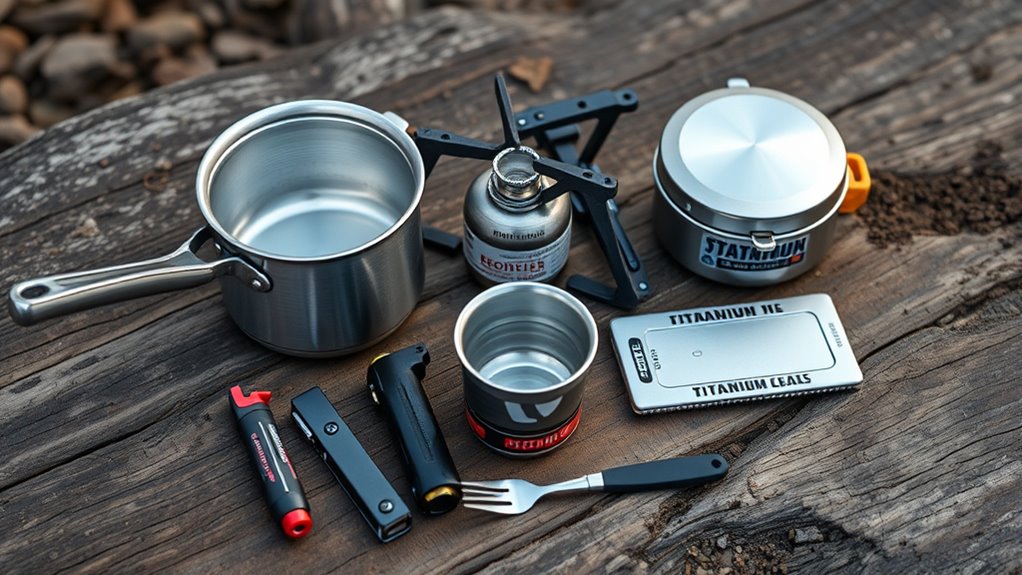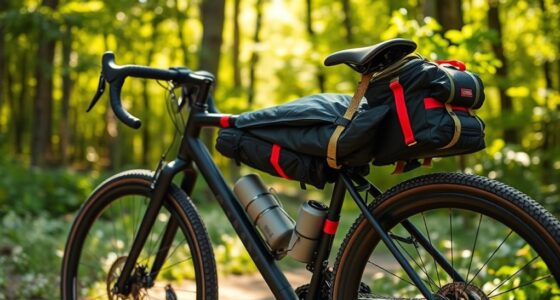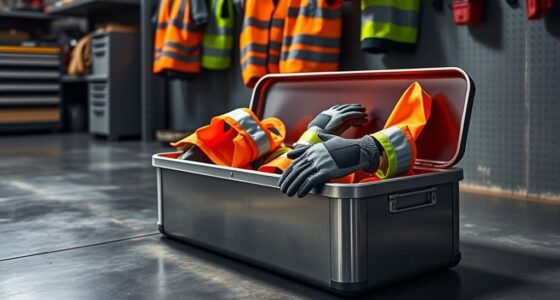When choosing cooking gear for bikepacking, look for lightweight, durable options like titanium or aluminum pots, compact stoves (such as canister or alcohol burners), and versatile utensils that nest easily. Use natural resources, like small sticks, for open fire cooking where allowed, and organize your gear efficiently for quick setup and packing. Opt for budget-friendly kits and maintain your equipment well. Keep exploring to discover tips that will make your cooking gear even more reliable and efficient on the trail.
Key Takeaways
- Choose lightweight, durable cookware like titanium pots and mugs for efficient space and weight management.
- Opt for compact, multi-function stoves such as BRS-3000T or alcohol burners to minimize gear clutter.
- Use natural fire sources with supports like rocks for open fire cooking, reducing reliance on fuel canisters.
- Carry extra fuel or natural fuel sources and plan resupply points to ensure reliable cooking during trips.
- Organize gear with nesting, mesh bags, or straps for quick access, balancing affordability, durability, and weight.
Essential Principles of Lightweight Cooking Equipment
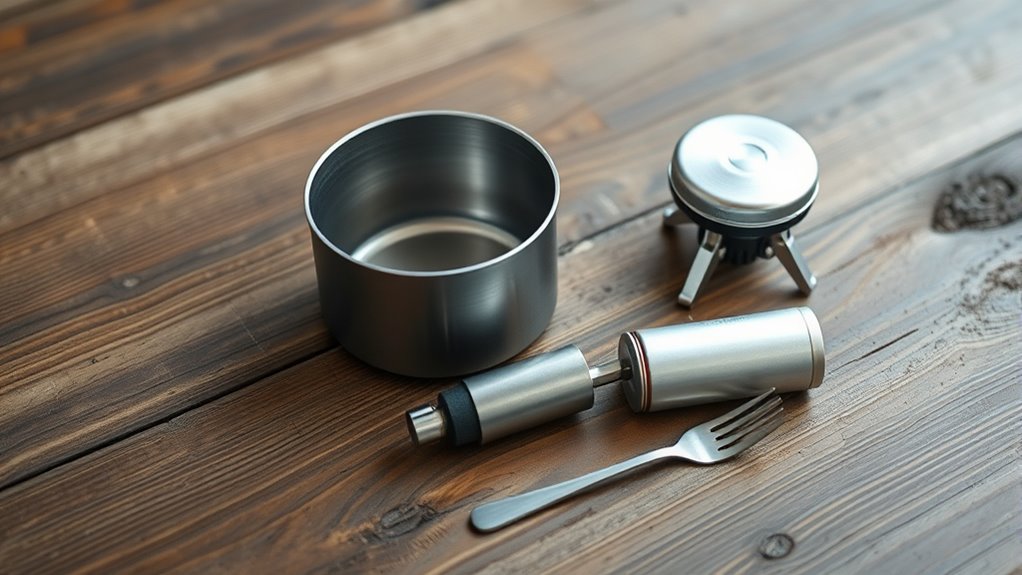
When choosing lightweight cooking gear for bikepacking, prioritizing materials like titanium and thin aluminum is essential because they strike a balance between durability and minimal weight. Titanium is ultralight, corrosion-resistant, and strong, making it ideal for pots, pans, and utensils. Opt for compact, nesting designs that allow you to pack everything—stove, pots, utensils—into a small bundle, saving space in your packing. Multi-functionality is key; look for stoves that combine features like windscreens or versatile utensils that serve multiple purposes. Your goal is to reduce gear clutter without sacrificing reliability. Additionally, selecting gear with specialized attachments can enhance functionality and streamline your setup. Incorporating efficient fuel options can also help reduce weight and improve overall performance. Selecting gear made with innovative materials ensures durability without adding unnecessary weight. Utilizing space-saving designs can further optimize packing efficiency and accessibility. Choosing gear that features multi-use components can further streamline your setup and reduce the number of items you need to carry. By focusing on durable yet lightweight materials and efficient design, your gear becomes easier to carry, more accessible, and ready for remote adventures. This approach ensures you stay efficient and well-prepared on your bikepacking journey.
Personal Gear Setups From Different Bikepackers
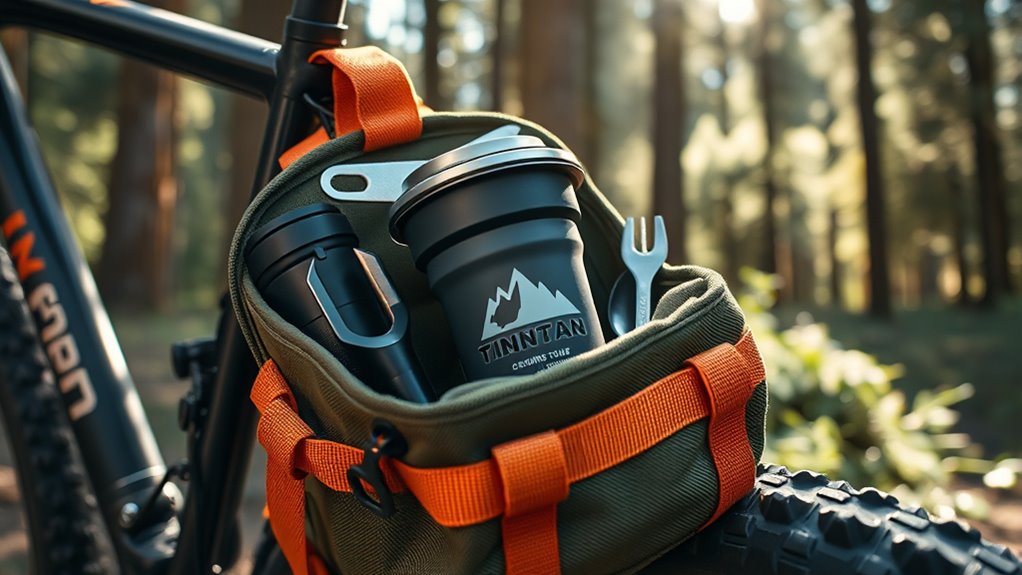
Bikepackers tailor their cooking setups to match their specific needs, terrain, and preferences, resulting in a diverse range of gear configurations. Some favor ultralight titanium pots, like Sophie DeGroot’s Snow Peak Ti-Mini Solo 2.0, paired with a denatured alcohol stove and open fires in dry environments. Others, like Cass Gilbert, prefer a 1.2L titanium pot with a Trangia spirit burner, using bioethanol for multi-day trips. Josh Meissner’s setup includes a simple BRS-3000 stove with a small pot, focusing on boiling water and minimal meals. Eileen Schwab’s long-term kit features a 2L titanium pot and a versatile stove, emphasizing organization. Meanwhile, Matty Waudby opts for a lightweight alcohol stove, a titanium mug, and gravity water filtration, prioritizing simplicity and weight savings. Incorporating sound therapy into their routines can also help cyclists stay relaxed and focused during long rides. Additionally, selecting appropriate fuel types that match their stove systems enhances efficiency and safety during extended trips. Using a compact and efficient stove system allows for quicker setup and less bulk in their gear.
Multi-Fuel and Canister Stove Options for Bike Touring
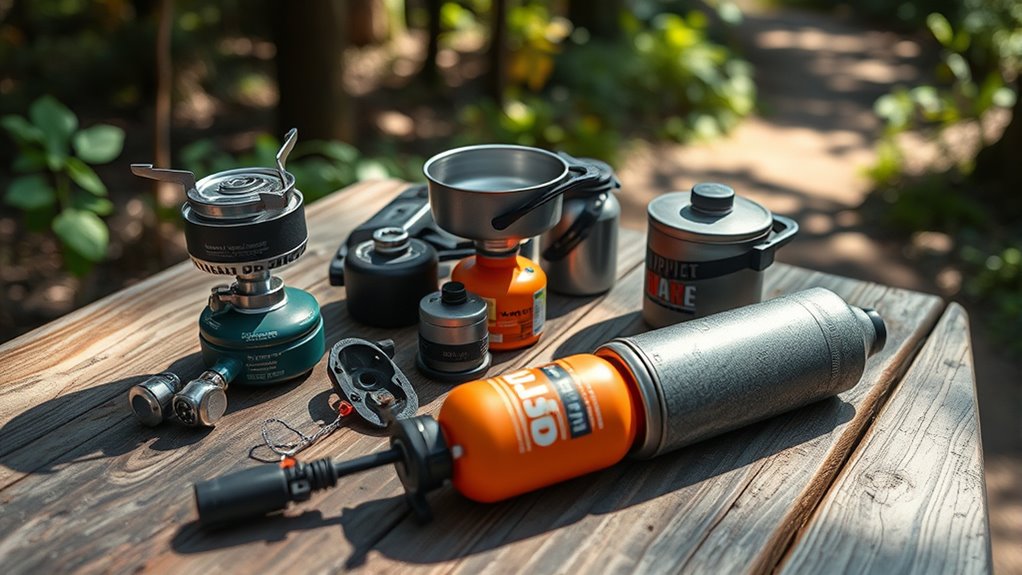
Choosing the right stove for bike touring depends on your specific needs and the conditions you’ll face. Canister stoves, like the MSR PocketRocket or Snow Peak GigaPower, are lightweight, boil water quickly, and are simple to operate, making them ideal for shorter trips. Multi-fuel stoves, such as the MSR WhisperLite or Primus Omnifuel, handle various fuels like gasoline or kerosene, offering versatility where fuel availability is limited. When selecting between these options, consider these factors:
- weight and portability
- fuel availability along your route
- trip duration and cooking needs
- compatibility with camping cookware
Canister stoves excel in convenience and speed, while multi-fuel stoves provide reliability in remote regions. Your choice hinges on balancing convenience with versatility, which can be influenced by the potential security vulnerabilities in certain technologies. Additionally, understanding survival gear can help you better prepare for unexpected situations that may arise during your trip.
Compact and Durable Cookware Choices

Opting for compact and durable cookware is essential for bikepackers aiming to maximize space without sacrificing resilience. Titanium cookware, like Snow Peak or Alpkit models, offers a lightweight (around 50-150 grams) and durable solution that withstands rugged conditions. Nesting cookware sets combine pots, lids, and foldable handles into a single compact package, making efficient use of limited space on your bike frame. These sets often feature stackable designs, ensuring everything fits neatly together. The foldable handles enhance portability and ease of packing, reducing bulk. Hard-anodized aluminum options provide a tough, lightweight alternative, typically weighing 100-200 grams. Reputable brands such as MSR, Snow Peak, and Alpkit produce corrosion-resistant, rugged cookware that’s built to last through open fires and rough handling. Additionally, understanding resources and tools can help you select the best gear suited for your specific needs and conditions. Incorporating advanced materials into your selection process can further improve durability and weight savings, and exploring innovative design features can optimize your packing efficiency and cooking experience in the field. Moreover, considering multi-functionality can help you reduce the number of items you carry while maintaining versatility.
Utensils and Organization for Efficient Cooking
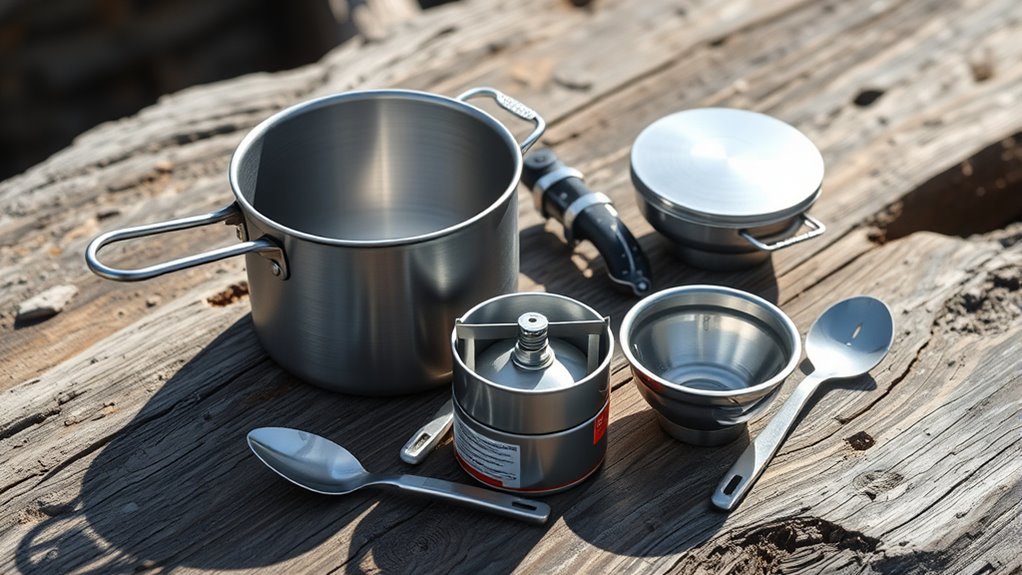
To cook efficiently on the trail, organizing your utensils and ingredients is essential. A well-structured setup ensures quick prep and easy access. Use lightweight, durable utensils like titanium sporks and long-handled spoons to cut weight and improve hygiene. Keep your gear tidy with mesh bags, ziplocks, or velcro straps to prevent clutter and streamline organization. Carry multi-functional utensils, such as a spork that serves as both a spoon and fork, to minimize gear and maximize versatility. Include a small chopping board or cutting surface for prep work, especially when space is limited. Use dedicated containers or bowls for leftovers and prep, preventing cross-contamination and simplifying cleanup. Proper organization and multi-purpose tools make cooking on the trail more efficient and enjoyable. Additionally, selecting high-quality best anime movies can provide relaxing entertainment during rest stops to keep morale high. Maintaining toilet etiquette and proper sanitation practices can also ensure a comfortable experience in outdoor settings. Organizing your gear with proper storage solutions can further enhance efficiency and safety in your outdoor cooking setup. Being aware of divorce guidance and legal considerations can help immensely if your outdoor adventure coincides with personal life changes, ensuring your focus remains on the journey.
Natural Resources and Fire Usage in Cooking
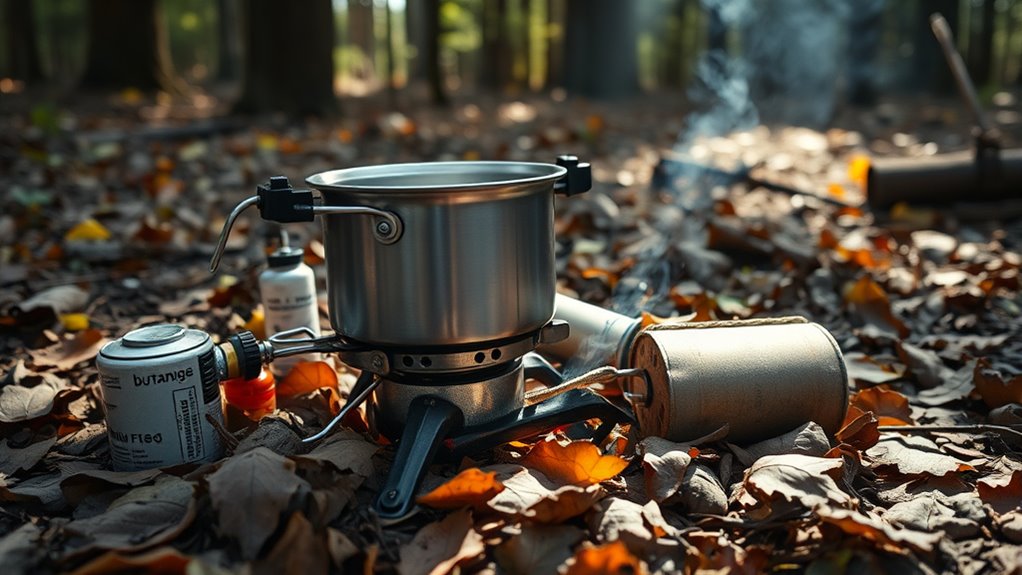
Using natural resources like small sticks and branches for fire allows bikepackers to cook efficiently while minimizing weight and dependence on fuel canisters. An open fire created with natural fire and resources offers a lightweight, sustainable cooking method, especially in dry environments where firewood is abundant. Elevating pots with rocks or natural supports helps you cook effectively over your open fire without extra gear. This approach reduces your reliance on fuel canisters, making your trip more eco-friendly and cost-effective. Additionally, understanding market trends and local regulations can help you choose the most appropriate and responsible cooking method for your environment. However, safety is vital—always verify your fire is fully extinguished and avoid environmental damage or wildfires. When fire bans aren’t in effect and natural firewood is plentiful, using natural fire and open fire techniques can be a practical, sustainable solution for bikepackers seeking lightweight, eco-conscious cooking options.
Budget-Friendly Stove Kits and Cost-Effective Gear

Budget-friendly stove kits offer bikepackers an affordable and lightweight way to prepare meals on the trail. For around $16.90, models like the BRS-3000T weigh just 29 grams and boil 500ml of water in about 10 seconds longer than pricier options. A complete ultralight cooking setup, including stove, titanium mug, and bikepacking accessories, can cost around $50 and weigh under 200 grams. These stove kits often use simple fuel sources such as canister gas, alcohol, or DIY wood gasifiers, making them versatile for different conditions. To maximize efficiency, choose lightweight, durable cookware like titanium or aluminum pots. When selecting budget-friendly gear, consider how your stove kit integrates with your cooking system for reliable, cost-effective performance on the trail. Emerging technologies such as compact, efficient fuel sources and smart design innovations are improving the performance and accessibility of bikepacking stoves.
Practical Tips for Maintaining and Using Your Setup

To keep your cooking system reliable on the road, make sure to regularly clean and inspect your stove and cookware. Using windshields and shielding can boost fuel efficiency and maintain steady heat in challenging conditions. Also, carry spare parts and store fuel carefully to prevent accidents and handle any gear failures quickly.
Regular Equipment Maintenance
Regular equipment maintenance is essential to keep your bikepacking stove and gear functioning safely and reliably. Regularly inspect stove seals, fuel lines, and connections for cracks or leaks to guarantee efficiency and safety. Clean your cookware and stove components after each trip to prevent corrosion, residue buildup, and performance issues. Check and tighten all fasteners and hinges to maintain structural integrity and avoid failures during use. Replace worn-out or damaged parts, like burners or igniters, promptly to uphold reliability on longer trips. Proper gear storage in a dry, ventilated area helps prevent deterioration and extends equipment longevity.
- Inspect stove seals, fuel lines, and connections regularly
- Clean cookware and stove components after every trip
- Perform fastener maintenance and tighten all hardware
- Use replacement parts when needed to ensure durability
Fuel Management Strategies
Effective fuel management is essential for reliable and efficient bikepacking. To optimize fuel use, carry extra fuel containers or transfer devices like FlipFuel to prevent running out mid-trip. Choose lightweight, efficient stoves such as the BRS-3000T or Trangia spirit burner to improve stove efficiency and reduce fuel consumption. Only boil the water you need, and pre-soak meals to cut down cooking time. Store fuel canisters in insulated or protected containers to maintain canister safety and prevent leaks caused by temperature changes. Planning your fuel resupply points in advance ensures you have access to canisters, alcohol, or natural fuel sources like wood. These strategies help you stay fueled without adding unnecessary weight, making your bikepacking experience more dependable and enjoyable.
Safe Usage Practices
Ensuring safe usage of your stove setup is essential for a trouble-free bikepacking experience. Always prioritize stove safety by choosing a stable surface away from tent walls, rain, and wind. Proper fuel storage is important; keep fuel canisters in a cool, dry place, away from heat sources. Adequate ventilation is necessary—keep your shelter open to prevent carbon monoxide buildup. Use a windscreen or homemade shield to protect your stove from gusts, ensuring even heating and reducing fuel waste. Regular leak checks on fuel lines and connections are critical to prevent fires or malfunctions. Remember to:
- Choose a stable, non-flammable surface
- Keep fuel in safe storage away from heat
- Maintain ventilation during stove use
- Perform leak checks before each use
Community Insights and Recommendations for Bikepackers
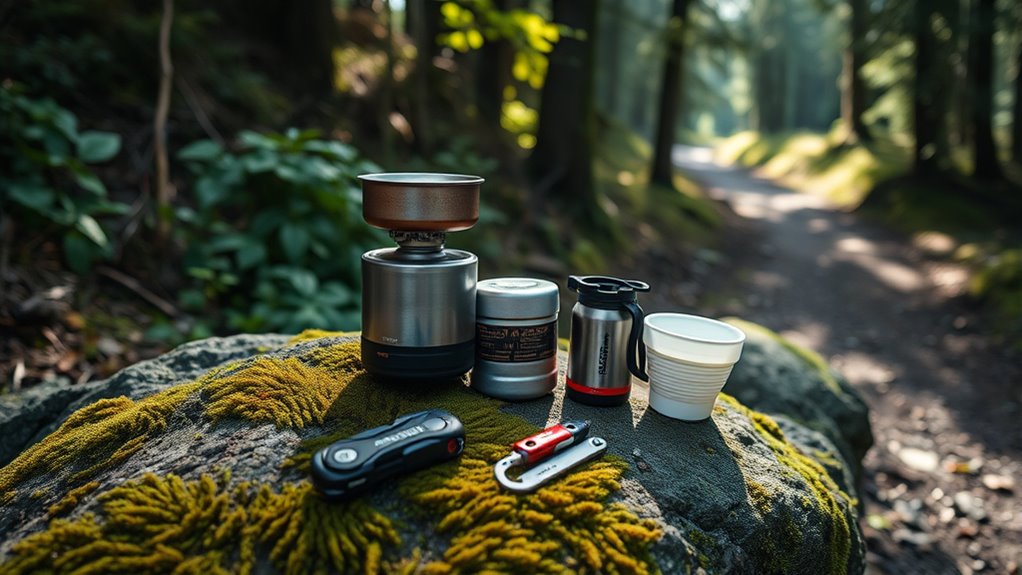
Community members consistently recommend lightweight, reliable stove setups for bikepacking, emphasizing the importance of testing gear beforehand to prevent surprises on the trail. A popular choice is the BRS-3000T stove (~29g) paired with a 650ml titanium cookware for efficiency and cost savings. They stress the need to contemplate regionally available fuel sources like gas cartridges, alcohol, or wood, ensuring you can cook reliably no matter where you are. Many favor multi-use cookware, such as nesting titanium mugs and pots, to save space and weight while offering versatility. Simple utensils like titanium sporks and multi-tools help keep your gear minimal. Proper organization, using mesh bags or straps, allows quick access. Overall, the community advises balancing affordability, durability, and weight, and thoroughly testing your setup for extended bikepacking trips.
Frequently Asked Questions
What Material Is Best for Cooking Over a Campfire?
When choosing the best material for cooking over a campfire, consider durability and heat resistance. Titanium is excellent because it’s lightweight, corrosion-resistant, and handles direct flames well. Cast iron retains heat superbly and works great for long cooking sessions, though it’s heavy. Hard-anodized aluminum heats quickly and is durable, making it a good option too. Avoid uncoated aluminum or stainless steel if weight or warping is a concern.
What Is the Best Cooking Method for Backpacking?
Think of your backpack as a tiny kitchen on the go. The best method for backpacking is boiling water with a lightweight stove, like canister or alcohol types. This approach is quick, efficient, and saves weight, letting you enjoy hot meals without the fuss. Using minimal cookware, like a small titanium pot or mug, makes cleanup a breeze and keeps your pack light.
What Food to Take for Bikepacking?
When choosing food for bikepacking, you want lightweight, calorie-dense options that fuel your ride without weighing you down. Pack trail mix, energy bars, dried fruits, and nuts for quick snacks. Include easy-to-make meals like instant noodles, dehydrated soups, or oatmeal that need minimal prep. Versatile ingredients like powdered mashed potatoes or rice flavored with seasonings add variety. Carry pre-cooked or freeze-dried meals to save time and guarantee you stay energized during long rides.
What Equipment Do I Need for Bikepacking?
When packing for bikepacking, you need essential gear that’s lightweight and versatile. Bring a compact stove, like a canister or alcohol model, and a durable pot or mug for cooking. Include utensils such as a spork or knife, and consider nesting cookware to save space. Don’t forget reliable fuel, a small cutting board, spice containers, and a water bottle or bladder. Focus on durable, multi-functional items to keep your load light and efficient.
Conclusion
When choosing your bikepacking cooking gear, remember that lightweight, durable options boost efficiency on the trail. Did you know that over 60% of bikepackers prioritize compact cookware to save space? By selecting versatile stoves and organizing your utensils well, you’ll enjoy hot meals without added weight. With the right gear and tips, you can make every ride more enjoyable and sustainable. Happy trails and tasty adventures await!
